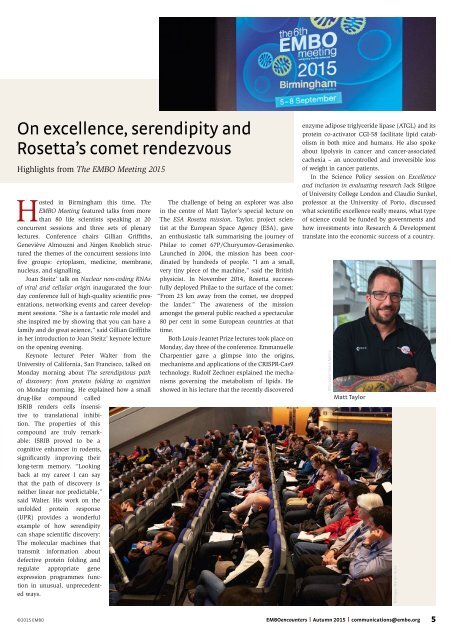Exploring
EMBO_encounters_issue31
EMBO_encounters_issue31
Create successful ePaper yourself
Turn your PDF publications into a flip-book with our unique Google optimized e-Paper software.
On excellence, serendipity and<br />
Rosetta’s comet rendezvous<br />
Highlights from The EMBO Meeting 2015<br />
Hosted in Birmingham this time, The<br />
EMBO Meeting featured talks from more<br />
than 80 life scientists speaking at 20<br />
concurrent sessions and three sets of plenary<br />
lectures. Conference chairs Gillian Griffiths,<br />
Geneviève Almouzni and Jürgen Knoblich structured<br />
the themes of the concurrent sessions into<br />
five groups: cytoplasm, medicine, membrane,<br />
nucleus, and signalling.<br />
Joan Steitz’ talk on Nuclear non-coding RNAs<br />
of viral and cellular origin inaugurated the fourday<br />
conference full of high-quality scientific presentations,<br />
networking events and career development<br />
sessions. “She is a fantastic role model and<br />
she inspired me by showing that you can have a<br />
family and do great science,” said Gillian Griffiths<br />
in her introduction to Joan Steitz’ keynote lecture<br />
on the opening evening.<br />
Keynote lecturer Peter Walter from the<br />
University of California, San Francisco, talked on<br />
Monday morning about The serendipitous path<br />
of discovery: from protein folding to cognition<br />
on Monday morning. He explained how a small<br />
drug-like compound called<br />
ISRIB renders cells insensitive<br />
to translational inhibition.<br />
The properties of this<br />
compound are truly remarkable:<br />
ISRIB proved to be a<br />
cognitive enhancer in rodents,<br />
significantly improving their<br />
long-term memory. “Looking<br />
back at my career I can say<br />
that the path of discovery is<br />
neither linear nor predictable,”<br />
said Walter. His work on the<br />
unfolded protein response<br />
(UPR) provides a wonderful<br />
example of how serendipity<br />
can shape scientific discovery:<br />
The molecular machines that<br />
transmit information about<br />
defective protein folding and<br />
regulate appropriate gene<br />
expression programmes function<br />
in unusual, unprecedented<br />
ways.<br />
The challenge of being an explorer was also<br />
in the centre of Matt Taylor’s special lecture on<br />
The ESA Rosetta mission. Taylor, project scientist<br />
at the European Space Agency (ESA), gave<br />
an enthusiastic talk summarising the journey of<br />
Philae to comet 67P/Churyumov-Gerasimenko.<br />
Launched in 2004, the mission has been coordinated<br />
by hundreds of people. “I am a small,<br />
very tiny piece of the machine,” said the British<br />
physicist. In November 2014, Rosetta successfully<br />
deployed Philae to the surface of the comet:<br />
“From 23 km away from the comet, we dropped<br />
the lander.” The awareness of the mission<br />
amongst the general public reached a spectacular<br />
80 per cent in some European countries at that<br />
time.<br />
Both Louis-Jeantet Prize lectures took place on<br />
Monday, day three of the conference. Emmanuelle<br />
Charpentier gave a glimpse into the origins,<br />
mechanisms and applications of the CRISPR-Cas9<br />
technology. Rudolf Zechner explained the mechanisms<br />
governing the metabolism of lipids. He<br />
showed in his lecture that the recently discovered<br />
enzyme adipose triglyceride lipase (ATGL) and its<br />
protein co-activator CGI-58 facilitate lipid catabolism<br />
in both mice and humans. He also spoke<br />
about lipolysis in cancer and cancer-associated<br />
cachexia – an uncontrolled and irreversible loss<br />
of weight in cancer patients.<br />
In the Science Policy session on Excellence<br />
and inclusion in evaluating research Jack Stilgoe<br />
of University College London and Claudio Sunkel,<br />
professor at the University of Porto, discussed<br />
what scientific excellence really means, what type<br />
of science could be funded by governments and<br />
how investments into Research & Development<br />
translate into the economic success of a country.<br />
© European Space Agency<br />
Matt Taylor<br />
© Images: Martyn Hicks<br />
©2015 EMBO<br />
EMBOencounters | Autumn 2015 | communications@embo.org 5


